How To Draw A Horse’s Head
When it comes to drawing a horse’s head, there’s no better way to start than with a picture of one. Working from a reference can make all the difference, as it helps to capture the horse’s personality and capture the correct proportions. To begin, use a light pencil and draw an oval shape that is slightly wider at the top and has a center line. This basic shape will be the horse’s head.
Once you’ve drawn the basic shape, it’s time to start adding detail. Begin by drawing the muzzle, centering it on the oval shape, and making sure it extends far enough for the nostrils. Then, draw two small eyes, two delicate ears, and a soft chin. When giving the horse character, make sure to include a few wrinkles or freckles if desired. After this, it’s time to draw the mane and forelock. Draw the mane curved, slightly above the neck and angled forward. The forelock should be wispy and voluminous, and the hair should stay uniform to give the horse a more realistic look.
Once you’re happy with the basics, add shading and other details like the nostrils, whiskers, and fur. Use light and dark shading to give the horse a soft, lifelike look. Take your time, and be sure to work on the shading gradually until it looks realistic. Don’t forget to add subtle details such as eyebrow markings and a wild twinkle in the eye.
The secret to a good horse’s head drawing is in the details. When shading, use a variety of techniques, such as cross hatching, stippling, and feathery strokes. This will bring life to the drawing and give the horse texture. Utilizing texture can also help to emphasize edges and bring out the roundness of the shape.
When drawing a horse’s head, you should also be aware of the different angles that it can be viewed from. Varying angles brings a dynamic look to the drawing, and creates a perspective that makes the image look more realistic. Take a few reference photographs, and try to create the same angles in your drawing. This will help to create an accurate portrayal that captures the emotion and spirit of the horse.
In addition to angles, you should also focus on lighting. By altering the direction of light you can change the way certain parts of the horse’s face look. For example, adjusting the light direction can make it look like a part of the animal is in shadow. Be mindful of this when working on the shadows, and attempt to make the shadows look real. This can help to bring the horse’s head drawing to life.
When it comes to drawing a horse’s head, it’s important to take your time and pay attention to detail. Even the smallest touches can bring a lot of life to the drawing. From anatomy and shading to angles and lighting, a little bit of work can make all the difference. With enough practice, you’ll soon be drawing beautiful horse’s head drawings with ease.
